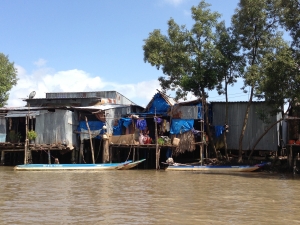Stopping charcoal production in Mui Ca Mau National Park: work without end
Stopping charcoal production in Mui Ca Mau NP
Location: Ha Noi, Viet Nam . 11th Jul 2013
In 2012, IUCN issued a small grant to the Mui Ca Mau National Park Management Board to support five local community mangrove protection groups. Last week, as part of a grantee monitoring visit, I attended a monthly meeting at which the protection groups report back to the management board on illegal mangrove cutting and their efforts to close down the charcoal kilns that are driving the mangrove cutting. In June 2013, the protection groups demolished more than 200 kilns. These are small kilns that earn households VND3,000,000/month. But past experience indicates that many of these kilns will quickly be rebuilt because the households have no other economic alternative.
Located on the southern tip of Vietnam between the East Sea and Gulf of Thailand, Mui Ca Mau National Park is Ramsar site and encompasses over 15,000 hectares of mangroves. Before the park was establishment in 2003, thousands of households lived in the core zone—where they remain today. Of the four communes inside the park, Dat Mui Commune has the highest number of households living in the core zone: 3,900. Of these, only 200 households have been allocated land. The remaining 3,700 households either have no land, or only enough for housing, because there is no more land to allocate. 819 households have less than 0.5 hectare. Since they cannot farm shrimp, and fishing is only possible in June-July when fish are plentiful, thousands of households depend on cutting mangroves and producing charcoal for a living.
Although the mangrove protection groups have done a good job destroying kilns, they expressed real concern about how poor landless families will survive. Some alternative livelihoods were suggested, such as community-based tourism and raising “Mud creeper” sea snails (Cerithidea obtusa) in the mangrove forest. But until these alternatives materialize at a scale to make a difference, charcoal kilns will remain a major threat to the park.
Although the project has ended, the park director said that he will continue to pay for these protection groups because of their success in securing local community support for mangrove conservation.

Landless households in the core zone, Mui Ca Mau National Park © Nguyen Bich Hien/MFF Viet Nam , 2013